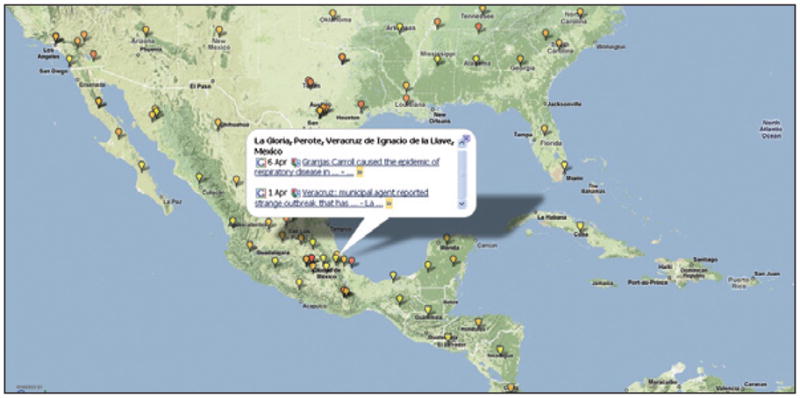The value of Web-based information for early disease detection, public health monitoring, and risk communication has never been as evident as it is today, given the emergence of the current influenza A (H1N1) virus. Many ongoing efforts have underscored the important roles that Internet and social-media tools are playing in the detection of and response to this outbreak.
In March and early April, while much of the world was focusing on the threat of avian influenza originating in Asia, intelligence-gathering systems were also extracting evidence of an epidemic of acute respiratory infections in Mexico. Early informal reports from the Mexican press indicated that a “mysterious” influenza-like illness was occurring in the town of La Gloria in the state of Veracruz, where it was reported that up to 60% of the 3000 inhabitants had been infected and 2 had died since early March. The Health-Map system, for instance, collected and disseminated a local media report describing this event on April 1, 2009 (see map).1 This report was followed by another on April 2 describing the possible role of Granjas Carroll, a U.S.-owned pig farm, in the epidemic.2 On April 10, the Global Public Health Intelligence Network (GPHIN) reported acute respiratory illness in Veracruz to the World Health Organization (WHO). This alert was followed by immediate communication among the WHO’s Global Outbreak Alert and Response Network, the Pan American Health Organization, and the Mexican Ministry of Health.3
Other informal media sources subsequently began to reflect the spread of the epidemic through parts of Mexico, including Oaxaca, Baja California, Mexico City, and San Luis Potosí. Reports of this outbreak did not appear in the English-language media until weeks later (April 21), when two children living near San Diego (neither of whom had been exposed to pigs) presented with mild respiratory symptoms and fever. In those cases, the Centers for Disease Control and Prevention had confirmed the presence of H1N1 on April 17.4 The timeline thus emphasizes the importance of surveillance of local information sources in local languages.
Epidemic-intelligence systems receive many reports of mysterious respiratory illness daily, and the decision to consider this event one of international significance requires interpretation of context — for example, of the level of background noise inherent in various data-mining systems. A fully moderated approach (in which each communication is reviewed by someone with expertise in the subject matter), such as that of the International Society for Infectious Diseases’ Program for Monitoring Emerging Diseases (ProMED), though potentially less timely, provides critical, evidence-based risk assessment. An in-depth evaluation is required to determine whether any earlier intervention efforts might have controlled the outbreak at the source. Clearly, this event also highlights the swift response capability of the global public health community.
The emergence of H1N1 has been subsequently tracked through both automated and manual data entry and visualization with the use of full-spectrum Web-based communication strategies. Though traditional official and media communication channels remain in place, Web-based mapping, search-term surveillance, “microblogging,” and online social networks have emerged as alternative forms of rapid dissemination of information. Understandably, some observers worry about their ability to inspire public concern beyond the necessary levels. Clearly, these tools must be used with restraint and appropriate evaluation.
Figure. Information on Suspected or Confirmed Cases of H1N1 Influenza That HealthMap Has Collected since April 1 from Mexico, the Southern United States, and Central America.

The balloon shows the initial reports from La Gloria, Veracruz. The markers represent locations where there have been unofficial reports about suspected or confirmed cases of H1N1 (not the individual cases themselves) as well as other reports of influenza and other respiratory illness. Darker markers indicate increased recent report volume.
References
- 1.Morales AT. Veracruz: reporta agente municipal extraño brote epidémico que ha cobrado dos vidas. La Jornada; Apr 1, 2009. [Google Scholar]
- 2.Martinez R. Extraño brote epidemiológico causa la muerte a dos bebés en Veracruz. Proceso; Apr 2, 2009. [Google Scholar]
- 3.Harris G. Questions linger over the value of a global illness surveillance system. New York Times; May 1, 2009. [Google Scholar]
- 4.Swine influenza A (H1N1) infection in two children — southern California, March–April 2009. MMWR Morb Mortal Wkly Rep. 2009;58:400–2. [PubMed] [Google Scholar]


